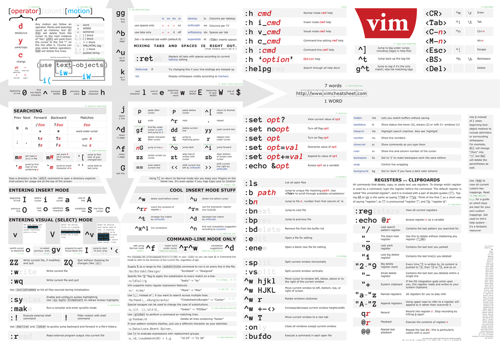

- #MACVIM CHEAT SHEET PDF PDF#
- #MACVIM CHEAT SHEET PDF CODE#
- #MACVIM CHEAT SHEET PDF DOWNLOAD#
- #MACVIM CHEAT SHEET PDF FREE#
To perform a query, pass a query-map to the $where function. Querying data sets with the $where functionĪnother new function, $where, lets you query an Incanter dataset using a syntax based on MongoDB and Somnium’s Congomongo Clojure library. (def results (-> (conj-cols data (:fitted lm) (:residuals lm)) We could have used the -> (thread) macro to perform both steps, as well as add the residuals from the output of linear-model to the dataset We can add more meaningful names with the col-names function.

col-0, col-1, col-2), this is done to prevent naming conflicts when merging datasets. You’ll notice that the column names are changed to generic ones (i.e. (def results (conj-cols data (:fitted lm))) We can create a new dataset that adds the fitted (or predicted values) to the original data using the conj-cols function. The conj-cols function returns a dataset by conjoining sequences together as the columns of the dataset, or by prepending/appending columns to an existing dataset, and the related conj-rows function conjoins rows.

(view (conj-cols (range (nrow $data)) $data)))
#MACVIM CHEAT SHEET PDF CODE#
For instance, the following code uses the conj-cols function to prepend an integer ID column to the dataset, and then displays it in a window. Within the with-data expression, the dataset itself is bound to $data, which can be useful if you want to perform operations on it. (doto (scatter-plot ($ :speed) ($ :dist)) (def lm (linear-model ($ :dist) ($ :speed))) dist), and then add a regression line using the fitted values returned from the incanter.stats/linear-model function. Within the body of a with-data expression, columns of the bound dataset can be accessed by name or index, using the $ function, for instance ($ :colname) or ($ 0).įor example, the following code will create a scatter plot of the data (speed vs. I will use Incanter’s new with-data macro and $ column-selector function to access the dataset’s columns. The data are 50 observations, from the 1920s, of automobile breaking distances observed at different speeds. We can see that there are just 50 rows and two columns and that the column names are “speed” and “dist”. We can get some information on the dataset, like the number of rows and columns using either the dim function or the nrow and ncol functions, and we can view the columns names with the col-names function. See the documentation for get-dataset for more information on the included sample data. The cars.csv file is a small sample data set that is included in the Incanter distribution, and therefore could have been loaded using get-dataset, (incanter.datasets/get-dataset :cars) The default delimiter is \, but a different one can be specified with the :delim option (e.g. Next load some CSV data using the incanter.io/read-dataset function, which takes a string representing either a filename or a URL to the data. Basic dataset functionalityįirst, load the basic Incanter libraries (use '(incanter core stats charts io)) Move to 3rd instance of character x back from cursor on current line.This post will cover some new dataset functionality I’ve recently added to Incanter, including the use of MongoDB as a back-end data store for datasets. Move to 3rd instance of character x forward from cursor on current line. Move to one character before the character x To the position before the latest jump, / where the last "m'" / "m`" command was given. Move to the first non-blank character of the line Move cursor to the start of the previous word Move cursor to the start of the next word You will have to complete a short form to access it for the first time only.
#MACVIM CHEAT SHEET PDF PDF#
So you’ll find that several Vim commands also function as Vi commands.įREE DOWNLOAD: This cheat sheet is available as a downloadable PDF from our distribution partner, TradePub. Keep in mind that Vim (Vi Improved) is a modified clone of the Unix-based text editor Vi, which ships with several Linux distros.
#MACVIM CHEAT SHEET PDF DOWNLOAD#
You can also download a PDF version of this Vim cheat sheet and save it to your desktop for quick access. We’ve even compiled the best Vim shortcuts into a cheat sheet for you! Scroll down to discover it. (This is essential given that Vim is a keyboard-centric text editor.) If you have only dabbled in Vim until now, the next step is getting comfortable with Vim commands i.e.
#MACVIM CHEAT SHEET PDF FREE#
The best part is that Vim is free and open source. This cross-platform command line text editor has been around for ages and has a solid online community you can look to for help. Powerful, efficient, and highly configurable-that’s Vim in a nutshell for you.


 0 kommentar(er)
0 kommentar(er)
